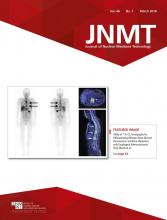Abstract
To prevent misleading imaging results, it is essential to attend to quality control and technical issues. An important technical parameter is selection of a zoom factor that is appropriate for the dimensions of the camera’s field of view and of the patient’s body. Here, we present the case of an atypically located Meckel diverticulum that, because of technical issues, mimicked the urinary bladder on a Meckel scan.
The Meckel scan is a valuable diagnostic procedure in nuclear medicine (1). Final interpretation of a Meckel scan, like other scintigraphic procedures, is vitally and directly influenced by the quality with which it is performed and the appropriateness of the imaging parameters for the individual patient (1). Here, we present the case of a young man with intermittent rectal bleeding referred to our department for a Meckel scan. Because the patient’s Meckel diverticulum was in an atypical location and the detector did not cover the entire abdominopelvic region, the abnormal hyperactive focus mimicked the urinary bladder during the dynamic acquisition.
CASE REPORT
A 19-y-old man presented with complaints of abdominal pain and occasional severe rectal bleeding beginning 3 wk before his admission to the intensive care unit. On the initial laboratory tests, a very low level of hemoglobin (6 g/dL) was detected. Emergent colonoscopy was performed but was not diagnostic because of excessive blood in the colon. Then, a Meckel scan was requested. The scan was performed using an SHG ADAC γ-camera (Philips), with close monitoring of the patient. Images of the anterior abdomen and pelvis were obtained in angiographic and 1-h dynamic phases after intravenous administration of 370 MBq of 99mTc-pertechnetate. A matrix size of 128 × 128 and a zoom factor of 1.46 were selected. The angiographic findings were unremarkable (Fig. 1), but the 1-h dynamic images (Fig. 2) revealed a mid-pelvic focus of gradually accumulating radioactivity, which moved slightly and slowly from right to left during the second half of the dynamic phase. After completion of the dynamic scan, anterior and lateral spot views of the pelvis were also obtained; these showed the patient’s urinary bladder, which appeared as a second intense focus of radioactivity inferior to the first (Fig. 3). One day later, the patient underwent pelvic surgery for resection of a possible Meckel diverticulum. Pathologic investigation confirmed the diagnosis.
Meckel scan angiograms of abdomen were unremarkable.
Dynamic Meckel scan with 1-min framing rate was acquired for 1 h. Hyperactive focus can be seen at mid pelvis.
Anterior (left) and right lateral (right) pelvic spot views of Meckel scan show bladder inferior to hyperactive focus.
DISCUSSION
Meckel diverticulum is a congenital malformation of the gastrointestinal tract resulting from failure of the omphalomesenteric duct to close. About 10%–60% of Meckel diverticula contain gastric mucosa, which can secrete acid and enzymes. Bleeding, a major complication of Meckel diverticulum, occurs after irritation and ulceration of the intestinal mucosa by this acid and enzymes. Bleeding is more common in children but also occurs in adults. In some cases, it can be severe or even life-threatening (2,3). Although a Meckel diverticulum is usually in the right lower quadrant of the abdomen, its location can be anywhere in the abdomen or pelvis (4).
There have been several reports in the literature of false-negative Meckel scans, some of which were caused by technical issues (1,5). A limited field of view—leading to incomplete coverage of the region of interest (e.g., thoracic or abdominopelvic region)—is an important technical cause of false-positive results. As can be seen in the present case, in which a small portion of the lower pelvis was outside the field of view, this issue is more problematic in dynamic studies. Although our case had clues that the focus was atypical of the bladder (early visualization, gradual movement, and no change in size), a less experienced technologist or physician may not notice the issue and the results may therefore be misleading.
In this regard, to achieve high-quality images the technologist must be aware of the need to accurately estimate the boundaries of body regions and must set the zoom factor in accordance with the dimensions of the field of view and of the patient’s body, especially in tall adults. Obtaining multiple overlapping static spot views or additional lateral or oblique views can sometimes solve this problem.
CONCLUSION
This case emphasizes the need to ensure that a Meckel scan has an adequate field of view to prevent misleading results. Before allowing the patient to leave the department, the technologist must check the images to ensure that they cover the complete region of interest.
DISCLOSURE
No potential conflict of interest relevant to this article was reported.
Footnotes
Published online Nov. 10, 2017.
REFERENCES
- Received for publication July 2, 2017.
- Accepted for publication August 29, 2017.










